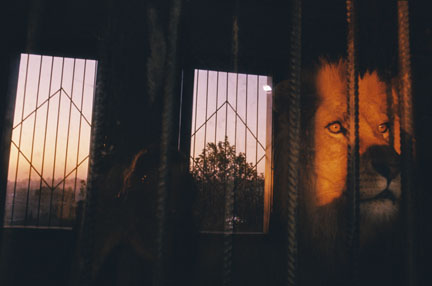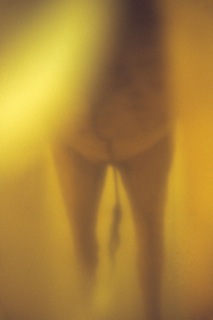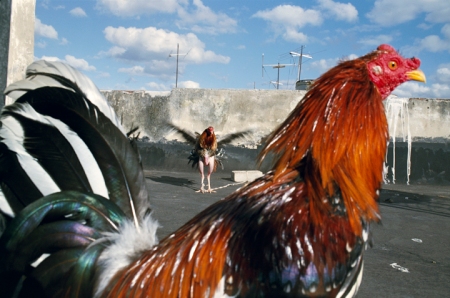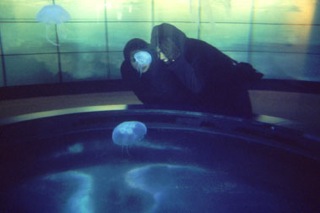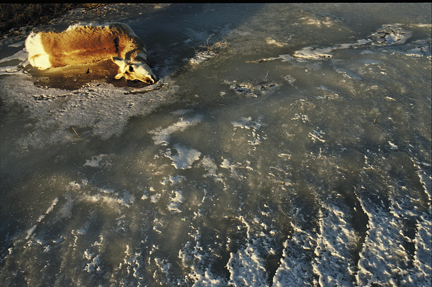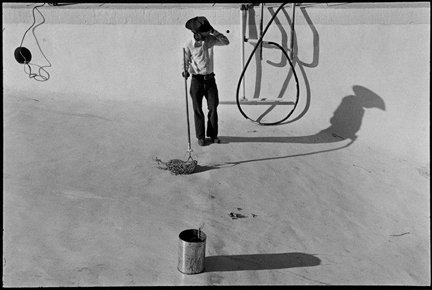The TWO QUESTIONS column this month features questions from photographers from TWO CONTINENTS: Matthew Goddard-Jones from Australia and Carolyn Beller, originally from Alabama. Matthew’s dynamic, playful, and often surprising images from his long-term project, “Pastimes,” perfectly echo his subject matter, Australians at play. Carolyn’s curiosity about the world has led her from her potter’s studio in Chicago to follow her relatively new passion of photography in Myanmar, Rwanda, and other countries around the globe. You can read more about each photographer –– and be linked to their work –– at the end of this column.––Alex Webb and Rebecca Norris Webb

RNW, St. Francis, Rosebud Indian Reservation, SD, from "My Dakota"
ON TEXT AND PHOTOGRAPHS AND ON EARLY INFLUENCES
MATTHEW GODDARD-JONES: Rebecca, do you consider the writings in your books as stand alone imagery, or do they add to the visual images?
REBECCA NORRIS WEBB: One of my artistic obsessions is exploring how text and images can work together in a photo book to illuminate one another. I’m a writer as well as a photographer, so I tend to see in images, whether I’m using a pen or a camera. So I guess in a way what I’m also exploring is a form that echoes my own creative process, especially when that process is trying to deal with something as complicated as loss, from the loss of our natural world –– as in my first book, “The Glass Between Us” –– to a private loss, as in the book I’m working on now, “My Dakota.”
For me, I like to think of text and photographs as equal elements in a book, as if they were all notes in the same piece of music, or images in a single poem. With each book, I try to figure out the particular relationship between the two that makes the most sense for that particular body of work and the themes that accompany it. Broadly speaking, I guess I would say that my combining text and photographs has something to do with how I experience the world, and also how this experience is translated in how I build my own photography books ––image by image (sometimes using text, sometimes photographs), page by page, so that the emotional resonance and/or suggestiveness of each image spills over onto the next, allowing each image to be awash with all the others. This kind of layering — image by image, page by page — colors and shades the body of work until it’s shaped into a completed photo book, a process similar to the creation of a painting or a poem.
For instance, now nearing the completion of “My Dakota,” I’m only now beginning to understand that the my repeated use of shrouds and veils in this series reminds me of the villanelle, a poetic form in which lines/images often repeat, yet each time they repeat, the meaning varies somewhat. Perhaps I was intuitively drawn to this sort of villanelle-style repetition/variation in both my text and photographs because it’s a form that closely reflects the process that the grieving and troubled mind goes through while grappling with what is lost and –– simultaneously and paradoxically –– what can never be lost. And it’s probably no accident that one of my favorite poems is a villanelle about loss, Elizabeth Bishop’s “One Art.”
CAROLYN BELLER: Alex, it seems that the art of photography is sometimes very misunderstood. Most people would never dream that they could compose a brilliant concerto, paint a masterpiece, or write a classic novel, as these works of art are created by artists out of nothing. A photographer has a camera and in a split second captures what actually exists. It would seem that if a dog, some people, a building, a road exists than we all can see those things and yet a great photographer sees these same things in a very different way. Your iconic images are SO complex. Most people can’t see contrast, shape, color, gesture, scale, expression, and composition in a 3D world expressed as a 2D image. Do you think that you were born with an acute visual awareness or have you developed it over the years by taking hundreds of thousands of images? Have you always sought visual stimulation and have you always been visually curious? What were some of the things that interested you as a child?
ALEX WEBB: It’s always a little hard to have any kind of perspective about one’s self and evaluate the influences on one’s work. But I’ll make a stab at it.
I’m quite sure that how I photograph was greatly influenced by my upbringing. I come from a family of artists: my mother is a sculptor and draftsman; my father, though a publisher and editor, was also a writer; my brother is a painter; and my sister, who partially escaped the family’s artistic tradition by studying biology, ended up becoming an ornithological illustrator as well as an author of illustrated children’s books. Art was everywhere in our house when we were growing up: whether we were hanging out in my mother’s studio, listening to my father discuss fiction, or going to museums with both parents. So from an early age I was exposed to all kinds of visual and literary stimulation. As a child and well into my teen years, I tried to paint, to sculpt, and — especially later on, and somewhat more seriously — to write fiction. Fortunately the world was spared these efforts and I became a photographer.
But that predominantly explains something about the urge to become an artist — it doesn’t explain the particular nature of how I see the world as a photographer. I suspect that early exposure to various modernist painters — especially De Chirico and the Cubists — influenced how I see. Their paintings still rattle about in the back of my head. And of course I have been deeply influenced by the stream of street photographers, from Cartier-Bresson and Kertesz on to Frank and Friedlander. And there are writers — Graham Greene, Conrad, Garcia Marquez, Vargas Llosa — whose vision of the world has certainly influenced where I have chosen to work and how I perceive some of my chosen locales. But I think there may be a further, ultimately more personal, influence. My father was an incredibly nuanced thinker, a man who often discovered alternative perceptions, who seemed drawn to complexity. I don’t think I inherited the conceptual complexity of his way of thinking — I’m certainly not the thinker he was — but perhaps something about his attitude toward the world, his embrace of complexity, wore off on me. As a photographer I am always looking for more — more elements that qualify or transform the image. This is not just a drive towards visual complexity for complexity’s sake — it is something ultimately more philosophical. And in that sense perhaps it parallels something about how my father seemed to perceive the world.
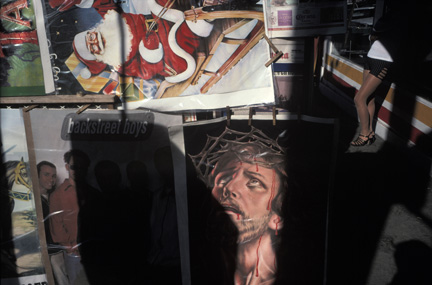
AW, Tijuana, Mexico, 1999, from "Crossings"
ON WORKING NEAR VS. FAR; ON UNPEOPLED FRAMES
MGJ: Alex: Is it easier to photograph away from your own environment? If so, why?
AW: I don’t think it is easier or more difficult to photograph away from one’s own environment. It’s just different. That said, I think that in the act of photographing, when there is that sudden moment of recognition, when somehow all those elements come together and become a photograph, I think it’s pretty much the same. It’s just that the process of getting to the moment is different.
In the mid-seventies after graduating from college, I felt that my photographs were becoming dead, predictable. I began to look outside of the world of New England and New York that I had been photographing. I went to Haiti, to northern Mexico, eventually to other parts of the Caribbean and Latin America. I discovered worlds where life seemed to be lived on the stoop and in the street, a world of immediacy and energy, far from the gray-brown reticence of New England. The brilliant light and intense color that I discovered in these places compelled me to eventually start working in color, which I continue to do to the present.
Was it easier to choose this route than another? Not necessarily. Some of the places I have chosen to work in are resistant to photography. Others less so. But it was the right route for me at that time for my work.
Now, however, having wandered the globe for some thirty years, I am interested in returning to the United States and photographing more here. Will it be easier? More difficult? I don’t know for sure. I think it’s always very difficult to take truly interesting photographs.
CB: Rebecca, in your layout for your upcoming book, My Dakota, I see that you have included few images with people in them. In The Glass Between Us, however, you include many images of people but they are primarily reflected images. Why have you made these choices in each book?
RNW: As I mention in my introduction to “The Glass Between Us”, this work began thanks to a serendipitous visit to the Coney Island aquarium, where I saw a beluga whale that appeared to be floating high over the heads of a group of people, whose images were reflected in the glass tank. I first thought, “I’ll get rid of that reflection,” and then realized, “No, that’s what’s interesting…the relationship between the people looking at the whale and the creature itself.” The project expanded from aquariums to zoos to natural history museums. Many of the photographs are of reflections of people on glass aquarium tanks or the glass walls of monkey houses, capturing the moment when the person was spontaneously responding to the animal he or she was watching. So the literal reflection on the glass is also a kind of musing/reflection on the nature of the relationship between a particular animal and a particular viewer/visitor.
Yet, even in this body of work, two of my favorite images contain no people at all, merely the vestiges of them: a faded African savannah mural painted in the 1930’s on the walls of the giraffe enclosure in a Paris zoo; the crooked seams of a crudely-sewn belly of a giraffe specimen in an Italian natural history museum.
Thinking about those images now, I wonder if they in some small way helped to prepare me –– unconsciously, creatively, intuitively –– for what I could not possibly be prepared for –– how to respond to the unexpected death of my first immediate family member, my older brother, Dave. I don’t know the answer, or even if there is an answer. What I do know is that, thankfully, I felt compelled to take my camera back to my home state of South Dakota during those darkest days of my life.
That’s not say that I always managed to push the shutter. Some days, all I did was drive and drive and drive, often without encountering another human being for miles. So a major reason this work is relatively unpeopled is because that reflects my actual experience photographing this sparsely-populated Great Plains state. That said, in many of these images, there’s often signs of people –– a tinted car window in the badlands, a faded painted teepee on a ruined Lakota motel, an animal skeleton on a barbed wire fence near Pine Ridge. I guess you could say that “My Dakota” is inhabited by the abandoned belongings and other traces of people, something that may well begin to explain the work’s elegiac tone.

Matthew Goddard-Jones, from "Pastimes"
Matthew Goddard-Jones is a freelance photographer based in Western Australia, who studied graphic design at the London College of Printing. Always seeking to challenge himself to develop as a photographer, he has recently attended Magnum workshops in Australia and New York.
Matthew is passionate about documenting people in their own environments, and is currently working on a long-term project “Pastimes,” documenting the changing face of the sports, hobbies, and other activities in Western Australia. He has exhibited widely.
Matthew’s website

Carolyn Beller, Burma, 2008
Carolyn Beller is a native of Montgomery, Alabama and graduated from Tulane University with an M.F.A. in Studio Art and a minor in Art History. She has lived, worked and studied art, language and interior design in Italy, France, Japan, Austria and New York. Carolyn has been making utilitarian pottery since 1980. She has maintained a pottery studio and taught art in Chicago where she now lives with her husband and three dogs.
Carolyn’s work in photography started in earnest in 2006. In her own words:
“In 2006, I traveled to Rwanda to fulfill my childhood dream of seeing Mountain Gorillas in the wild. Returning home I began to read everything I could find about the history and the people of Rwanda and promised myself that, one day, I would return with more knowledge and a “real” camera. Later that year I traveled to the Terai in western Nepal to work on a pottery project with the indigenous Tharu people who are hunter-gatherers well known for their ancient skills as artisans.
I took my first digital SLR on that trip and realized that a camera could be an invaluable tool to see deeper into a people and their culture. Photography has opened my eyes even wider. I am amazed by the world everyday.”
Carolyn has attended photography workshops, and studied with Nevada Wier, Catherine Karnow, Jay Maisel, David Alan Harvey, Alex Webb and Rebecca Norris Webb. She has traveled to Laos, Thailand, Myanmar, Turkey, and throughout the U.S to study and to make photographs.
Last year, she returned to Rwanda with a “real” camera.
CAROLYN’S WEBSITE
